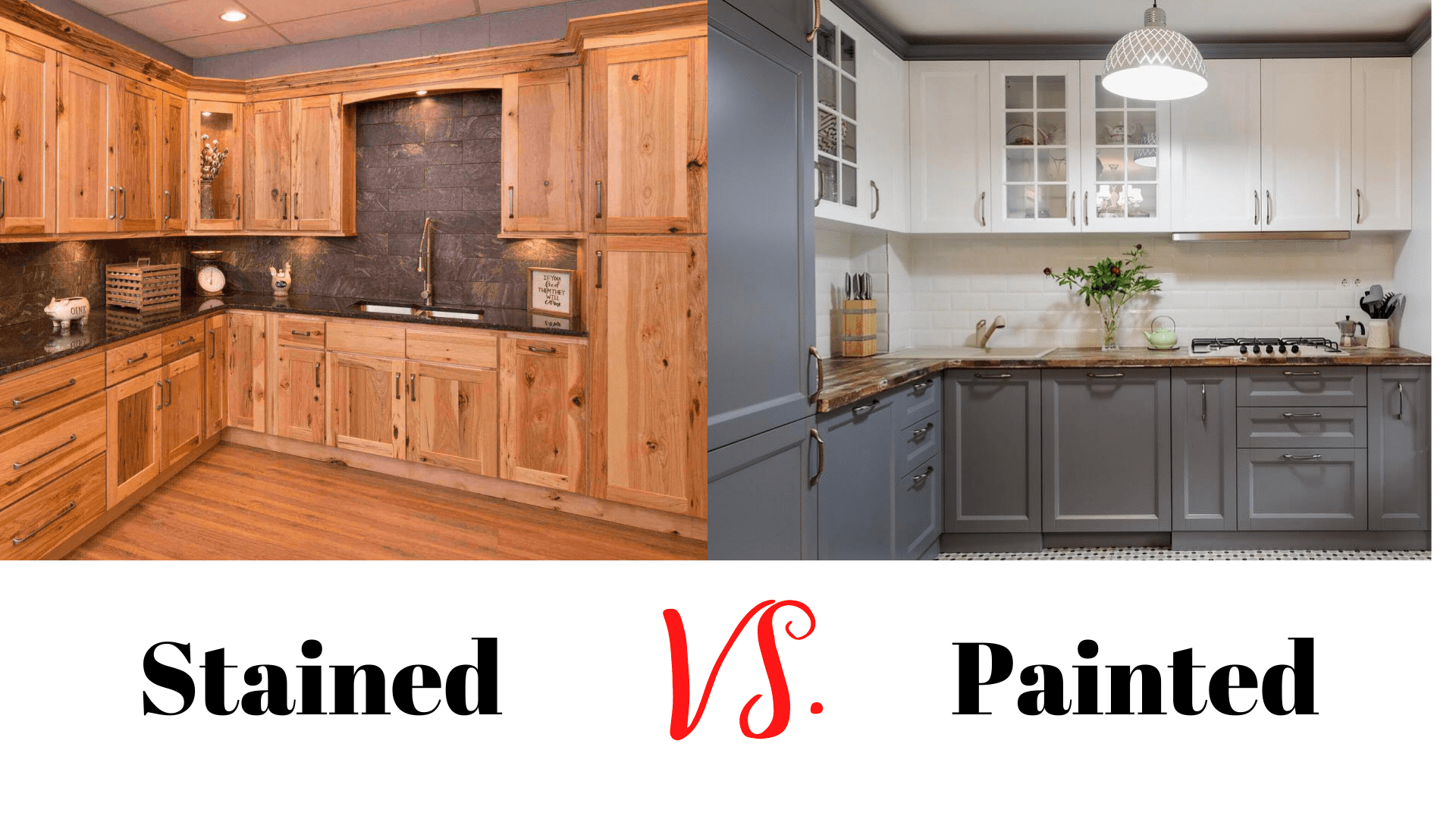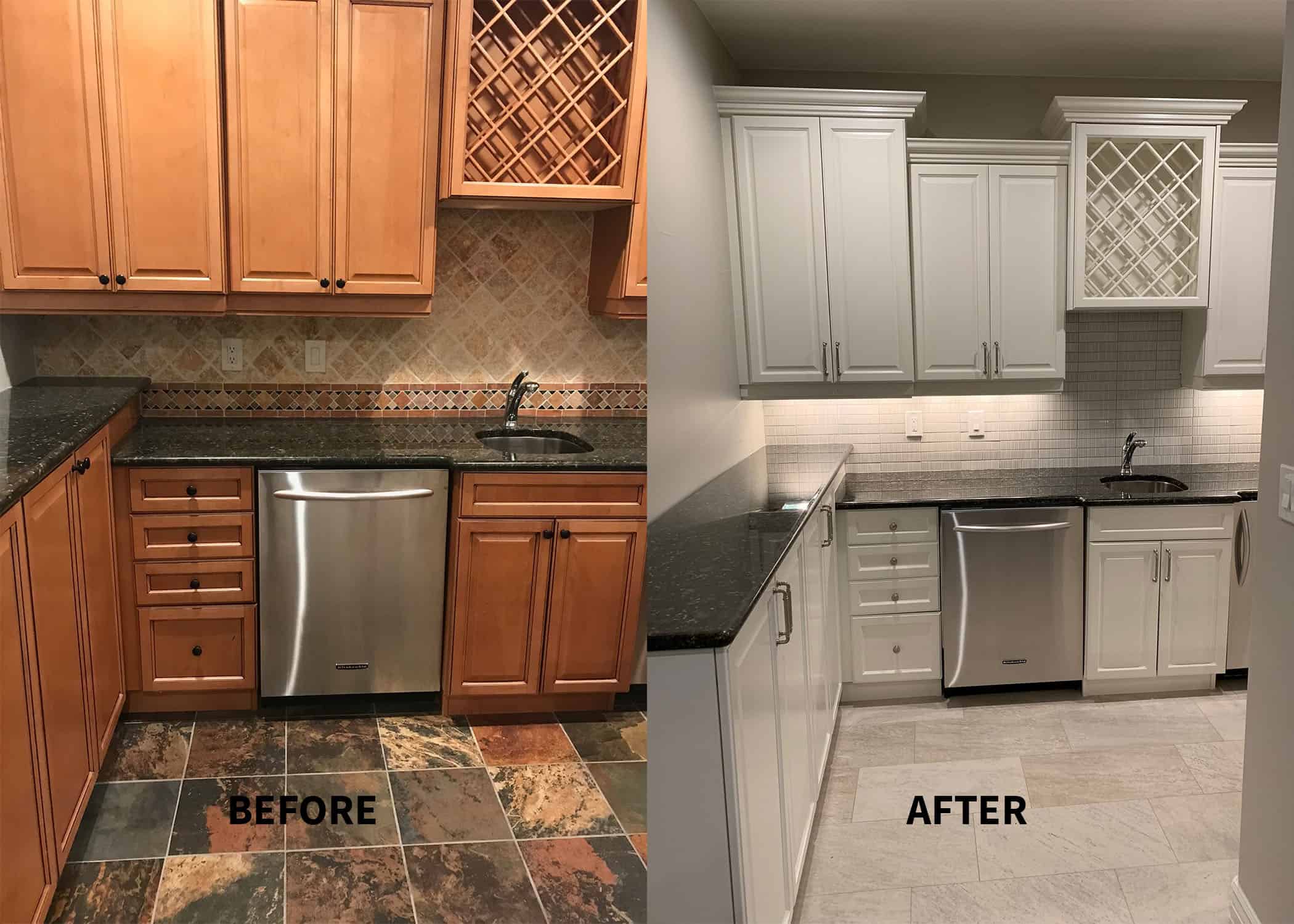Understanding the Difference Between Paint and Stain

Before diving into the world of kitchen cabinet finishes, it’s crucial to understand the fundamental differences between paint and stain. While both enhance the appearance of your cabinets, their methods of application, final appearance, and durability vary significantly.
Paint Versus Stain: A Detailed Comparison
Paint and stain offer distinct advantages and disadvantages, each catering to specific aesthetic and functional needs. Understanding these differences is vital in selecting the ideal finish for your kitchen cabinets.
Pros and Cons of Paint
Paint is a versatile coating that provides a solid, opaque layer of color. It effectively covers existing colors and textures, allowing for a complete transformation of your cabinets.
- Pros:
- Wide Color Range: Paint offers an expansive spectrum of colors, enabling you to achieve any desired hue.
- Easy Application: Applying paint is relatively straightforward, even for beginners.
- Excellent Coverage: Paint effectively hides imperfections and provides a smooth, uniform finish.
- Durable: Paint is generally durable and can withstand regular wear and tear.
- Cons:
- Can Obscure Wood Grain: Paint creates a solid layer, hiding the natural wood grain and texture.
- Requires More Prep Work: Proper preparation, including sanding and priming, is essential for a successful paint job.
- Can Chip or Peel: While durable, paint can chip or peel over time, especially in high-traffic areas.
Pros and Cons of Stain
Stain, unlike paint, penetrates the wood’s surface, enhancing its natural beauty by bringing out its grain and color.
- Pros:
- Preserves Wood Grain: Stain allows the natural wood grain to shine through, adding warmth and character to your cabinets.
- Easier Application: Stain application generally requires less prep work compared to paint.
- Adds Depth and Dimension: Stain creates a rich, multi-dimensional finish that enhances the wood’s natural beauty.
- Cons:
- Limited Color Options: Stain primarily enhances existing wood tones, offering a more limited color range than paint.
- Less Durable: Stain provides a thinner layer of protection compared to paint, making it more susceptible to scratches and wear.
- Requires Regular Maintenance: Stain requires regular maintenance, including re-staining or applying a protective sealant to maintain its appearance.
Paint and Stain in Kitchen Cabinet Applications, Should i paint or stain my kitchen cabinets
When choosing between paint and stain for your kitchen cabinets, consider the unique demands of this high-traffic space.
Resistance to Moisture and Heat
Kitchens are susceptible to moisture and heat, both of which can impact the longevity of your cabinet finish.
- Paint: Modern paints formulated for kitchen cabinets offer excellent moisture and heat resistance. These paints often include a polyurethane or epoxy resin that creates a durable, protective layer.
- Stain: While stain alone doesn’t offer the same level of moisture and heat resistance as paint, applying a sealant after staining significantly enhances its durability.
Scratch Resistance
Kitchen cabinets are prone to scratches from everyday use.
- Paint: Paint, especially when paired with a durable topcoat, offers good scratch resistance. However, softer paint finishes may show scratches more readily.
- Stain: Stain, being a thinner layer, is more susceptible to scratches. Applying a protective sealant can help mitigate this issue.
Factors to Consider When Choosing Between Paint and Stain

Choosing between paint and stain for your kitchen cabinets is a decision that hinges on a multitude of factors. The right choice can transform your kitchen into a culinary masterpiece, while the wrong one could leave you with a space that feels out of sync. Let’s delve into the key considerations that will help you make the most informed decision.
Kitchen Style
The style of your kitchen plays a pivotal role in determining whether paint or stain is the more suitable option. A traditional kitchen, for example, often benefits from the warmth and natural beauty of stain, allowing the wood grain to shine through. Think of a farmhouse kitchen with rustic wooden cabinets, where stain would enhance the authenticity and charm. Conversely, a modern kitchen with sleek lines and minimalist aesthetics may be best served by paint, which provides a clean, crisp look and allows for bolder color choices. Imagine a contemporary kitchen with white cabinets, where paint creates a sense of openness and airiness.
Existing Cabinet Condition
The current condition of your cabinets is a crucial factor in deciding between paint and stain. If your cabinets are in good shape with minimal scratches or imperfections, stain can be a fantastic choice, as it enhances the wood’s natural beauty. However, if your cabinets are marred by significant damage, paint offers a more forgiving solution, as it can effectively conceal blemishes and create a uniform surface. Consider cabinets with noticeable scratches or water damage. Paint can effectively mask these imperfections, giving your cabinets a fresh start.
Level of Customization
The level of customization you desire is another important consideration. Paint offers a wider range of options for color and finish, allowing you to create a truly unique look. With paint, you can achieve everything from bold and vibrant colors to subtle and muted shades. You can also choose from various finishes, such as matte, satin, or gloss, to create different levels of sheen. Stain, on the other hand, provides a more natural look that complements the wood’s inherent characteristics. It offers a limited range of colors, primarily shades of brown, and the final color is influenced by the wood’s grain and species. Think of a homeowner who wants to create a dramatic contrast with their cabinets. Paint offers the flexibility to choose a bold color like navy blue or black, while stain would provide a more subtle and muted effect.
Impact on Kitchen Brightness
The chosen finish can significantly impact the overall brightness and spaciousness of your kitchen. Light colors, especially when applied with a glossy finish, tend to reflect light and create a more open and airy feel. This is especially beneficial in smaller kitchens. Dark colors, on the other hand, can absorb light and make a space feel smaller. If you have a small kitchen and desire a bright and airy ambiance, painting your cabinets white or a light shade of gray with a glossy finish can make a world of difference. Conversely, if you have a large kitchen and want to create a cozy and intimate atmosphere, consider staining your cabinets a dark wood tone.
Practical Considerations for Painting or Staining Kitchen Cabinets: Should I Paint Or Stain My Kitchen Cabinets

Painting or staining your kitchen cabinets is a significant undertaking, demanding meticulous preparation and execution. It involves a series of steps, each crucial to achieving a flawless and long-lasting finish. This section will guide you through the process, offering insights on preparing the cabinets, choosing the right paint or stain, applying it effectively, and ensuring a safe and successful project.
Preparing Cabinets for Painting or Staining
Adequate preparation is the foundation for a successful paint or stain job. It involves a series of steps that ensure a smooth, even surface for the application of paint or stain. This preparation process helps to enhance the adhesion and longevity of the finish.
- Remove Hardware: Before embarking on any sanding or cleaning, it is essential to remove all cabinet hardware, including hinges, knobs, and pulls. This allows for thorough cleaning and sanding of the entire cabinet surface.
- Sanding: Sanding the cabinets is crucial for creating a smooth surface that will allow for optimal paint or stain adhesion. Start with a coarse-grit sandpaper (80-120 grit) to remove any rough spots, imperfections, or old finishes. Progress to a finer grit sandpaper (150-220 grit) for a smoother finish.
- Cleaning: After sanding, thoroughly clean the cabinets to remove dust, debris, and any remaining residue. Use a mild detergent and a damp cloth to clean the surfaces. Ensure they are completely dry before proceeding to the next step.
- Priming: Priming the cabinets is essential, particularly when painting, as it creates a barrier between the wood and the paint, enhancing adhesion and preventing the wood from absorbing the paint, which can lead to uneven color. Choose a primer specifically designed for cabinets or wood.
Selecting the Right Paint or Stain
Choosing the right paint or stain is critical to achieving the desired aesthetic and ensuring durability. Consider the following factors when making your selection:
- Finish: Determine whether you want a glossy, semi-gloss, satin, or matte finish. Glossy finishes are more durable and easier to clean but can highlight imperfections. Matte finishes are less reflective and can hide imperfections but are less durable.
- Color: Consider the overall color scheme of your kitchen and choose a paint or stain that complements the existing decor. You can use color swatches or consult with a professional designer for inspiration.
- Type of Paint or Stain: For painting, consider using an oil-based paint for a durable finish that resists moisture and stains. Water-based paints are easier to clean up but may require multiple coats. For staining, choose a stain that is compatible with the type of wood and the desired color.
Applying Paint or Stain
Applying paint or stain evenly and efficiently is crucial for a professional-looking finish. Follow these steps for a successful application:
- Preparation: Ensure the area is well-ventilated and protected from dust and debris. Use drop cloths to protect the floor and surrounding surfaces.
- Application: Use a high-quality brush, roller, or spray gun to apply the paint or stain. For painting, apply thin, even coats, allowing each coat to dry completely before applying the next. For staining, apply a thin, even coat, wiping off any excess stain with a clean cloth.
- Drying Time: Allow the paint or stain to dry completely according to the manufacturer’s instructions. This typically takes several hours, but it’s important to wait for the recommended time before handling the cabinets.
Protecting Your Kitchen and Yourself
Painting or staining kitchen cabinets can be messy, so it’s essential to protect your kitchen and yourself during the process. Here are some tips:
- Ventilation: Ensure proper ventilation to avoid inhaling fumes from paint or stain. Open windows and doors or use a fan to circulate fresh air.
- Protective Gear: Wear a respirator mask, gloves, and eye protection to protect yourself from paint or stain fumes and contact.
- Clean Up: Clean up spills and drips immediately to prevent staining or damage. Use a damp cloth to wipe up spills and a scraper to remove any dried paint or stain.
Should i paint or stain my kitchen cabinets – Choosing between painting or staining your kitchen cabinets can be a delightful dilemma. The color and finish can significantly impact the overall feel of your space, much like how choosing the right sliding closet doors for your bedroom can enhance its aesthetic appeal.
For instance, if you’re looking for a sleek and modern look, you might consider sliding closet doors for bedrooms ikea in a minimalist design. Ultimately, both kitchen cabinets and closet doors offer a chance to personalize your home with touches of style and functionality.
Choosing between painting or staining your kitchen cabinets can be a delightful challenge, like deciding on the perfect finishing touch for a treasured heirloom. While you’re considering the final look of your kitchen, it’s wise to also ensure the security of your home, perhaps with a reliable set of bedroom door locks from Walmart.
Just as a fresh coat of paint can revitalize a space, a robust lock can bring peace of mind. So, as you envision your kitchen’s transformation, remember the importance of safeguarding your home as well.
